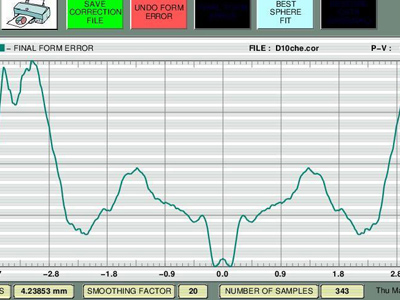The difference between spherical and aspheric lenses: a spherical lens refers to a constant curvature from the center to the edge of the lens, while a non-spherical lens has a continuous curvature from the center to the edge. Spherical lens refers to a corrective lens with the same radius of curvature on the surface of the lens, like the cross section of a sphere. An aspheric lens refers to a corrective lens in which the central area of the lens is designed with a spherical surface, and the curvature of the lens is gradually changed at a certain rate from a specific position from the optical center. The radius of curvature of the surface is inconsistent.
The "curvature of the spherical surface" of the spherical lens is constant, that is, the front and back surfaces of the lens are part of the spherical surface respectively. Each surface can be convex (convex outward from the lens), concave (recessed into the lens), or "flat" (flat). The line connecting the spherical center points of the front and rear surfaces of the lens is called the optical axis of the lens. In almost all cases, the optical axis of the lens passes through the physical center of the lens. The radius of curvature of the aspheric lens changes with the central axis, which has a better radius of curvature and can maintain good aberration correction. Surface curvature is one of the differences between spherical and aspheric lenses.
The difference between spherical and aspheric lenses in design: The main parameters considered in the design of spherical lenses include refractive power, refractive index, center thickness and base curve. Base curve usually refers to the refractive power of the front surface of the lens. For a given refractive power, the choice of base curve is very important for the optical imaging quality of the lens. The design of flat base curve can improve the appearance of the lens, reduce the thickness of the lens, control the magnification of the lens, and reduce the weight of the lens, but it will increase the aberration of the lens. In order to retain the advantages brought by the flat base curve design, an aspheric design can be used to eliminate the increased aberrations.
The difference between spherical and aspheric lenses: Aspheric lenses are used to replace spherical lenses. The most significant advantage is that they can correct the spherical aberration caused by the spherical lens in the collimation and focusing system. By adjusting the surface constant and the aspheric coefficient, the aspheric lens can eliminate the spherical aberration to the greatest extent. The aspheric lens basically eliminates the spherical aberration produced by the spherical lens. At present, the main processes of aspheric lenses are: precision glass compression molding, precision polishing molding, hybrid molding, and injection molding.

 Call us on:
Call us on:  Email us:
Email us:  R&D Center: Aoti Street #68 Building 4A 405 International R&D park, Nanjing
R&D Center: Aoti Street #68 Building 4A 405 International R&D park, Nanjing









 English
English  cn
cn  de
de  es
es  fr
fr 


